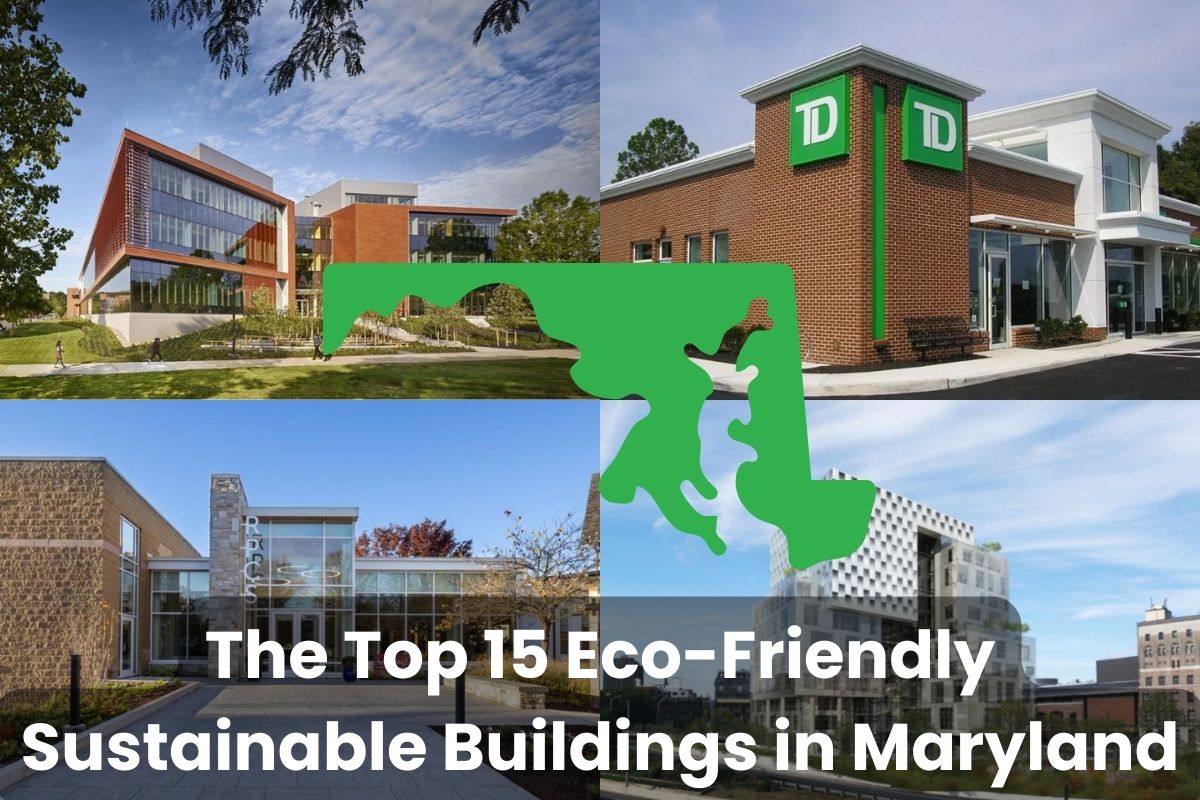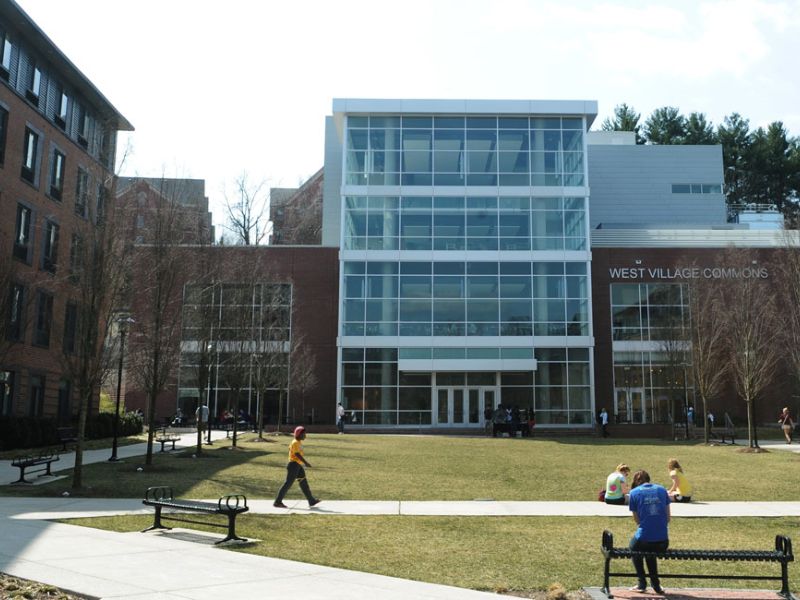The Top 15 Eco-Friendly Sustainable Buildings in Maryland

Images courtesy of ArchDaily, Patch Media, ArchDaily, and Roland Park Country School (RPCS).
Besides their environmental benefits, eco-friendly buildings have reported a 20 percent lower maintenance cost than their conventional counterparts. This helps to explain why builders and homeowners in Maryland, as well as elsewhere, are shifting toward sustainable construction.
Thanks to this shift in approach, there are many eco-friendly sustainable buildings in Maryland that incorporate modern technologies which support environmental conservation.
Eco-friendly construction encompasses a building’s planning, design, construction, and use. These processes must promote energy, water, and natural resource conservation to ensure a sustainable building has minimal environmental impact throughout its lifecycle.
In this article, I’ll discuss the top 15 eco-friendly sustainable buildings in Maryland, including how they meet green building requirements. Hopefully, this will inspire you to include sustainable building practices in your next project. Keep reading to learn more!
1. Center for Natural Sciences, Mathematics, and Nursing

This is one of the top eco-friendly sustainable buildings in Maryland due to its LEED Platinum certification.
The Center for Natural Sciences, Mathematics, and Nursing in Bowie, Maryland, has sustainable features that make it water and energy-efficient. These features are the reasons for its LEED Platinum certification.
The facility was assessed in terms of indoor environmental quality, energy conservation, and sustainable site development.
The 149,000-square-foot (13,800-square-meter) center incorporates sloped landscaping to prevent stormwater from running onto the pavements.
It has a computerized ventilation system that makes it more energy efficient and samples air quality continuously to adjust airflow as needed.
Other sustainable features include:
- 25,000-square-foot (2,300-square-meter) glazed windows that tint on demand. The tinting lowers energy consumption by 20 percent.
- A heating and cooling system that uses the chilled beam and convection technology to reduce energy consumption.
- Native plants provide shade that acts as a natural buffer from the sun’s rays.
- A greenhouse for plant sciences research.
2. TD Bank

Located in Bowie, TD Bank is a LEED Gold v2009-certified building under the Retail New Construction category. It was certified in 2012 with a scorecard of 63 points.
The 2,837-square-foot (264-square-meter) facility is close to a bus stop, facilitating public transportation among its employees. This reduces the number of personal cars on the road, lowering carbon dioxide emissions.
The building’s roof is made with materials that have an excellent solar reflectance index to reduce the urban heat island effect.
It also incorporates water-efficient landscaping practices like native plants and using captured rainwater for irrigation.
Other green building features include:
- Water-saving initiatives: It has low-flow plumbing fixtures that reduce indoor water consumption.
- Energy-saving: It has an energy-efficient HVAC system, LED lighting, and smart lighting technology to conserve energy. It also has ample windows that facilitate daylighting to reduce the need for artificial lighting.
- Material sourcing: The building was made mainly with locally sourced materials to reduce the need for transporting them over long distances to minimize its carbon footprint. Also, these materials contain recycled content, conserving natural resources.
- Waste management: Most of the construction waste was diverted from landfills through recycling.
- Indoor environment quality: It was made with low-VOC paints, sealants, carpets, and adhesives to enhance indoor air quality.
3. Angelos Law Center

This is a building owned and operated by the University of Baltimore’s Law School. It was the first law school in the U.S. to attain LEED Platinum certification.
Angelos Law Center was designed to be contemporary and sustainable.
Its sustainability goals were to achieve abundant natural lighting, water and energy conservation, and indoor environmental quality to enhance the students’ experience.
The Center has ample operable windows that circulate fresh air to reduce the cooling load. There is a computerized system that opens and closes these windows automatically based on indoor ventilation needs.
It has a rainwater harvesting system that captures and filters stormwater for reuse, which saves a considerable amount of potable water.
Angelos Law Center has an atrium with a transparent curtain wall façade for light diffusion into the classrooms. This maximizes daylighting, reducing the demand for artificial lighting during the day to conserve energy.
Other key features include:
- A heat-recovery enthalpy wheel in the mechanical air exchange system for heat conservation.
- A radiant heat and cooling system to supplement a two-mode ventilation system.
- Automated exterior blinds to prevent solar heat gain.
- Use of recycled, sustainable building materials.
- A green roof to reduce stormwater runoff.
- Energy-efficient LED bulbs and photocell technology.
- Eliminated 1.7 million pounds of carbon dioxide emissions by using fly ash as the cementing agent.
4. Roland Park Country School (RPCS)

RPCS is a member of the Green Schools Alliance at the Climate Steward Level. It’s also one of the few sustainable schools in Maryland.
The school has some of the most eco-friendly sustainable buildings in Maryland. Furthermore, it fosters activities that promote sustainability.
RPCS incorporates the highest energy conservation standards by leveraging passive cooling and lighting. Most of its buildings have ample operable windows that facilitate ventilation.
Additionally, the windows facilitate daylighting, lowering the need for artificial lighting.
The school reduces its carbon footprint by supplementing mains electricity with solar energy. It has a 35.88-kilowatt photovoltaic rooftop solar panel array that supplies electricity mainly for lighting.
The solar panel array helped offset 32.3 tons (29,300 kg) of carbon in its first year of installation.
It also promotes green cleaning by using 100% Green Seal-certified products.
Other sustainable features include:
- Single-stream recycling, composting, and paper recycling to divert waste from landfills.
- A reflective white roof to minimize the heat island effect.
- A green roof for stormwater management and additional insulation.
- Low-flow plumbing fixtures for indoor water conservation.
- Low-VOC caulking, adhesives, and paint.
5. Towson Green Town Homes

Towson Green Town Homes has some of the top eco-friendly sustainable buildings in Maryland.
The facility’s location near the Towson Town Center Mall is one of its unique, sustainable features. Residents can walk to stores, malls, and restaurants, reducing carbon dioxide emissions from cars.
Moreover, its proximity to bus stations promotes public transportation to reduce the number of vehicles on roads.
The construction team created a tight continuous envelope to increase the homes’ insulation for energy conservation. It also has high energy-efficient materials that prevent heat loss.
The homes feature low-flow plumbing fixtures, shower heads, and faucets. These features help save 40 percent more water for indoor use.
Other environmentally friendly initiatives include:
- Energy-efficient windows and appliances.
- An energy-efficient heating and cooling system.
- LED lighting fixtures.
- Passive lighting through design orientation based on the sun’s angle.
6. Towson University’s Residence Tower

This tower became LEED Gold-certified in 2019 due to its measurable green building design, operations, construction, and maintenance.
Although the tower was built in 1972, the certification came after a two-year renovation that made it more eco-friendly.
The 100,000-square-foot (9,300-square-meter) building demonstrates Towson University’s commitment to sustainability. It promotes water and energy efficiency, indoor environmental quality, and efficient use of materials.
The residence conserves more indoor water through its use of low-flow plumbing fixtures. It also has efficient bathroom fixtures that meet LEED standards for water efficiency.
The building’s efficient air conditioning and heating system conserves more energy, reducing its carbon footprint.
The university implements a green cleaning policy throughout the tower by avoiding the use of harmful cleaning products and chemicals. Instead, it uses 100% Green Seal-certified cleaning products.
Other sustainable features include:
- Renovation debris was diverted from landfills through recycling.
- Low-VOC paints, carpets, sealants, and adhesives for indoor air quality.
- Sustainable site development.
7. Thea Bowman Hall

Located in Baltimore, Thea Bowman Hall features some of the best sustainable building technologies.
The hall was built with over 80 percent recycled materials to conserve natural resources. Most of these materials were also sourced locally within a 500-mile (800-km) radius, reducing transportation carbon emissions.
The project resulted in minimal construction demolition to minimize waste generation. Also, the construction team preserved most of the trees on the site and planted 70 more.
The project incorporates a high amount of eco-friendly materials. For example, all its structural steel contains 90% recycled content, and bathroom stalls and toilet partitions in the hall are made from recycled steel.
Thea Bowman Hall conserves energy through maximum daylighting. It has ample windows facilitating the diffusion of natural light, reducing the need for artificial lighting during the day.
The hall’s other key green features include:
- Permeable paving paths to minimize stormwater runoff.
- Low-VOC paints, sealants, and adhesives for a quality indoor environment.
- A sustainable geothermal energy heating and cooling system.
- LED and high-efficiency compact fluorescent lighting fixtures throughout the units to reduce energy consumption.
- Sustainably sourced solid wood to conserve forests.
- High-thermal performance and insulation materials.
- A 20,000-square-foot (1,900-square-meter) highly insulated green roof that conserves energy and reduces stormwater runoff.
8. Ridley Athletic Complex

The most outstanding sustainability feature of Ridley Athletic Complex is its construction on a remediated site.
The Loyola University of Maryland reclaimed a site formerly used as a landfill to build the complex. Over 200 trees were planted during the remediation to improve the new forest areas and the ecosystem.
The 6,000-seat stadium complex sits on a 50-acre (20-hectare) site and showcases the highest level of sustainable construction.
The university recycled most of the construction waste to divert waste from landfill and ensured that construction materials incorporated recycled content to save natural resources.
Finally, most materials used to construct the stadium were sourced locally to minimize transportation carbon emissions, lowering the facility’s carbon footprint.
9. Fernandez Center for Innovation and Collaborative Learning

The Fernandez Center for Innovation and Collaborative Learning is one of the top eco-friendly sustainable buildings in Maryland with a focus on water and energy conservation.
The building opened in September 2021 and was Loyola’s first LEED-certified project.
The 35,000-square-foot (3,300-square-meter) facility was designed to create a comfortable learning environment while conserving the environment.
The building has an adjacent Green and Grey Café designed with sustainability in mind. The Café has a 100% living greenery wall that reduces heat gain, lowering the cooling load to conserve energy.
The center’s key sustainable features include:
- Efficient Lighting: The building uses 100% LED lighting fixtures to conserve energy. It also has smart systems like vacancy and occupancy sensors and light scheduling.
- Daylight harvesting: The center has ample operable windows that maximize daylight diffusion. Most occupied spaces can access direct outdoor views to facilitate natural light penetration.
- Air purification: The center has a rooftop air handling system with a high-end-grade unit that uses UV light to disinfect the air.
- Water conservation: It incorporates low-flow sinks and toilets. These features reduce its annual water consumption by 40%.
- Stormwater management: The facility has permeable paving, a 2,100-square-foot (195-square-meter) green roof, and a bioretention garden. These systems harvest and filter 100% of the site’s stormwater for irrigation.
10. Bowie City Hall

Located along 15901 Fred Robinson Way, Bowie City Hall opened in 2011 and is LEED Gold-certified owing to its numerous green building achievements.
The hall encompasses sustainable site development through alternative transportation. Its location near two Metro bus stops promotes the use of public transportation among its employees.
It also has a bicycle storage rack and parking for fuel-efficient and low-emitting vehicles.
The hall has a StormFilter under the parking lot for stormwater treatment. The filter removes impurities, nutrients, and oil from the water before being discharged to a stormwater pond for further purification before being released into a nearby stream.
The hall was designed with a partial green roof to reduce the urban heat island effect for a comfortable indoor environment.
Also, the wood used for the grille system, paneling, casework, and ceiling came from FSC-certified forests.
Other green building features include:
- Recycled materials: Over 20% of building materials contained recycled content like metals, concrete, masonry, veneer, joists, and beams.
- Indoor air quality: It was built with low-VOC carpets, sealants, adhesives, and paint.
- Water efficiency: The hall has low-flow, motion-sensor-operated plumbing fixtures. Its low-flow shower head emits 1.1 gallons (4.2 liters) of water per minute. These features have reduced the hall’s potable water use by 50%.
11. The Parks and Grounds Building

Located at 3106 Mitchellville Road, The Parks and Grounds Building is a LEED Silver-certified facility due to its diverse green features.
The building incorporates a ground-source heating system with 21 wells that are approximately 200 feet (61 meters) deep. These wells use geothermal energy for heating, reducing the facility’s energy consumption and carbon footprint.
It also has a 175-square-foot (16.3-square-meter) green roof planted with sedum cultivars for additional insulation, stormwater management, and reducing the heat island effect.
It also has the following key features:
- Motion-activated lights for energy conservation.
- Infrared heaters powered by natural gas.
- Rainwater harvesting and filtration system that reduces potable water use by 10 percent.
- A solar hot water system.
- Light-directing panels for maximum daylighting.
- Sun tunnels that prevent solar heat gain.
- It reused materials like asphalt from a demolished building.
- Straw bale walls for efficient insulation.
12. Tyler Hall

Located in Baltimore, Tyler Hall is a LEED Gold-certified building with numerous green building features.
Owned and operated by Morgan State University, the hall was carefully crafted to meet the institution’s sustainability requirements.
During its construction, 30% of the materials were sourced locally to reduce carbon emissions due to transportation.
Moreover, recycling and reusing diverted over 85% of construction debris from landfills. This accounts for 992 tons (900,000 kg) of waste.
Tyler Hall conserves more energy through maximum daylighting. It has open corridors and office spaces along the exterior to maximize daylight sharing. Additionally, it has a light control system that lowers light intensity based on the amount of natural light.
Finally, it has light-colored roofing to minimize the heat island effect.
13. Morgan Business Center

Morgan Business Center is among the top eco-friendly sustainable buildings in Maryland with state-of-the-art features.
The LEED Gold-certified building has a central atrium with three skylights to maximize daylighting. It also reduces the building’s heat load by 35%.
Moreover, it features a southwest glass wall that facilitates light penetration in the afternoon.
The integrated rainwater harvesting and treatment system at the center is crucial for water conservation. The system collects and purifies stormwater from the building for use in landscaping.
The center has a usable green roof with views of downtown Baltimore. The roof shields the building against heat loss in winter and heat gain in summer to save heating and cooling energy.
Finally, its proximity to essential services like market centers, banks, and restaurants facilitates pedestrian commuting, reducing carbon emissions from cars.
14. The Center for the Built Environment & Infrastructure Studies

The Center for the Built Environment & Infrastructure Studies is a LEED Gold-certified facility in Baltimore. It was certified in 2013 with a scorecard of 43 points.
The 126,000-square-foot (11,700-square-meter) building is owned and operated by Morgan State University. It was designed to meet the university’s sustainability standards in water, energy, and resource conservation.
Its key sustainability features include:
- A green roof: It provides additional insulation to shield the building against heat loss, lowering the heating load.
- Solar energy: The center has a photovoltaic solar array that supplies power to supplement the mains electricity, reducing the building’s carbon footprint.
- Rainwater management: It has a rainwater harvesting and filtration system for runoff management.
- Bioretention pond: It holds stormwater to facilitate sustainable percolation.
15. The West Village Commons Building

This is a LEED Gold-certified building in Baltimore, Maryland, owned and operated by Towson University.
Its LEED Gold certification is evidence of its sustainability features that help to conserve the environment.
The West Village Commons Building was designed to meet the university’s sustainability goals and has the following green building features:
- Ample operable glass windows to maximize daylighting for energy conservation.
- Low-flow plumbing fixtures for indoor water conservation.
- Sustainable landscaping practices like native plants and drip irrigation to minimize outdoor water consumption.
- A green roof for additional insulation and stormwater management, which also minimizes the heat island effect.
- The preservation of existing specimens like Elm trees to preserve biodiversity.
Final Thoughts On Sustainable Buildings in Maryland
This list of the top 15 eco-friendly sustainable buildings in Maryland is a testament to what we can achieve if we make a conscious choice to build in ways that conserve the environment.
Incorporating sustainable construction features in your project will help you save energy and water, lowering your utility bills. Such features are also an excellent way to conserve natural resources, reduce pollution, and mitigate climate change.
I hope these examples have inspired you to incorporate some of their approaches to sustainability in your next project.







